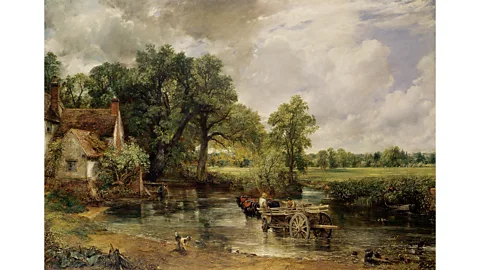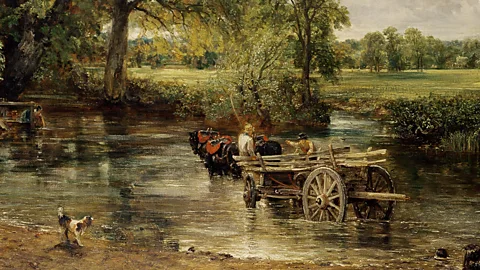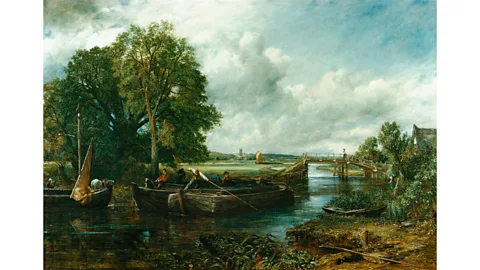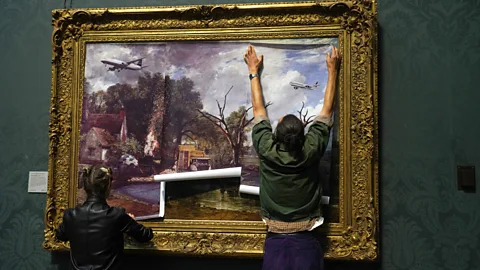 Getty Images
Getty Images
John Constable's The Hay Wain presents a bucolic view of England – but there's a dark side to the idealised rural image.
Widely satirised and reproduced on everything from bath towels to biscuit tins, John Constable's The Hay Wain (1821) is "the most celebrated and certainly quintessentially English landscape painting", says Alice Rylance-Watson, assistant curator for the National Trust, discussing the Area of Outstanding Natural Beauty that inspired the painting. But this rural scene featuring a hay wagon fording a Suffolk millpond is, she says, "an idealised image". In fact, the more we learn about The Hay Wain, the less we can trust its depiction of England.
Exploring the diverse meanings that artists past and present attach to the landscapes they depict is a new exhibition at Bristol Museum & Art Gallery, National Treasures: Constable in Bristol − "Truth to Nature", starring The Hay Wain. The iconic 6ft-wide oil painting, frequently voted one of Britain's favourite artworks, is on loan from London's National Gallery as part of the museum's bicentenary celebrations launching on 10 May. On its return to the National Gallery, it will be the focal point of Discover Constable & The Hay Wain, an exploration of the painting's creation and different reactions to it, opening in October.
 Getty Images
Getty Images
There's no doubt that Constable (1776-1837), who leaned more towards Romanticism than Realism, imbued his landscape with the sentimental attachment he had to it. He grew up just a mile from the whitewashed cottage to the left of the canvas, owned by tenant farmer Willy Lott, with its charming view over millpond and cornfields, and he rhapsodised about "the beauty of the surrounding scenery, its gentle declivities, its luxuriant meadow flats…", writing: "I associate 'my careless boyhood' with all that lies on the banks of the Stour".
Yet the rural way of life he depicted did not reflect the industrialisation that was rapidly altering the landscape at the time of painting. While his contemporary JMW Turner was painting a steam train slicing through the canvas, Constable was looking back rather than forward. In many ways, The Hay Wain is a scene that's too good to be true, an anachronism that speaks more to his nostalgia than offering a faithful portrait of rural Suffolk.

 Getty Images
Getty Images
Far from being an objective record of the countryside, the scene inevitably reflects Constable's own standing in society as the son of a landowner, Christine Riding, Director of Collections and Research at the National Gallery, tells the BBC. Just off-canvas is Flatford Mill, owned by the Constable family since 1742. "He knows that landscape very well, but he knows it from a position of privilege," she says. "It all looks very natural and contented. People know their place in society and are just getting on with it."
A darker side to rural bliss
But the scene is less happy when you consider the social context. The agricultural workers pictured in the background often laboured under poor conditions in a precarious and bloated employment market, could not afford to eat the bread that they helped produce, and were about to face even greater hardship when replaced by machines.
The picture also ignores the Enclosure Acts (between 1604 and 1914) that placed rural spaces in the hands of the few. "By the time you get to The Hay Wain, there is very little common land," explains Riding. "He's painting places that his father and his brother have ownership over… but you don't see owners, only labourers."
In some ways, he's offering up a fiction: a highly curated landscape containing elements that have been added later to improve the composition and broaden its appeal
As for depicting "nature", "there's nothing natural about that landscape," Riding says. "It's all man-made…The fields are agriculture, a managed landscape." And though Constable was a pioneer of painting en plein air, the masterpiece was painted from sketches gathered over almost two decades and completed back at his studio in Hampstead, London – then just a village but, within a century, subsumed into the capital's urban sprawl.
In some ways, he's offering up a fiction: a highly curated landscape containing elements that have been added later to improve the composition and broaden its appeal. The panting dog on the shoreline is one example, while, to its right, traces of an erased barrel and a mounted horse still linger beneath the water. Even the hay wain itself, the ultimate symbol of the English countryside, is not a hay wagon, but a wood cart, perhaps painted from a sketch sent to Constable in London, or, as new research suggests, from carts parked around Hampstead Heath's Whitestone Pond.

 Getty Images
Getty Images
Yet, in other ways, The Hay Wain is a paragon of verisimilitude, painted by an artist who was true to his artistic vision despite the low position landscapes occupied in the European Academies' hierarchy of artistic genres. "Constable is known for his attempts to be true to nature, and his commitment to painting a landscape that, for him, was very real," Julia Carver, curator of the Truth to Nature exhibition, tells the BBC. "He was working at a time when that was not fully understood by a lot of people in the artworld, and he still held to it."
Indeed, perhaps one of the reasons why The Hay Wain was not an immediate success when shown at the Royal Academy in 1821 is that it was too natural and too mundane for tastes at the time. But it was this same naturalism that saw it awarded a gold medal at the Paris Salon, where it was shown, along with View on the Stour near Dedham and Yarmouth Jetty, three years later. It was there that the writer Stendhal declared: "We have never seen anything like these pictures before. It is their truthfulness that is so striking."

 Getty Images
Getty Images
With the academic hierarchy in mind, "a lot of people who wanted to paint landscapes were starting to use history painting as a way to do it," says Carver, referencing Constable's predecessor Richard Wilson (1713-1782) and works by his contemporary, Turner, such as Dido building Carthage (1815). Constable, however, turns away from classicism and the temples, ruins and mythical beasts that populated the landscapes of many of his fellow painters, and he makes green, rather than the traditional brown, the dominant shade. Instead, he writes to childhood friend and fellow artist John Dunthorne about returning to Suffolk to make "laborious studies from nature" and create "a pure and unaffected" representation of the scenes.
"His copious work outdoors to prepare the end result does help us to see something that was really real, that was true to nature," says Carver. Constable's scientifically accurate cloud formations, for example, were the result of hours of meticulous observation and sketching while out "skying", as he called it. The authenticity of the painting's elements mattered to Constable, and its original title Landscape: Noon speaks to the precision he sought in its representation of the light and the sky.

 Getty Images
Getty Images
But for all his careful studies and sketches, some of which are on display in the Bristol and London exhibitions, The Hay Wain, says Christine Riding, is best understood as "an evocation". "Constable did not go in for a mimetic, optical-truth attitude to painting," she asserts. "It's a lifelong study of nature, but through the medium of oil paint".
Over the centuries, people have attached their own truths to the painting, Riding explains. At the time of painting, the Napoleonic Wars had made it clear that an English way of life could not be taken for granted, while the French Revolution and Peterloo were a reminder to families such as Constable's – who owned the means of production – that mobilised workers could upturn the old order at any moment. "Maybe he simply wants things to stay as they are," Riding suggests.

 Getty Images
Getty Images
The Hay Wain has continued to be totemic of an England that needs to be protected, but the threats have changed. In 1983, Peter Kennard's The Hay Wain with Cruise Missiles supported the Greenham Common protests against the siting of guided nuclear missiles in the English countryside; while in 2022, The Hay Wain became the focus of climate action when two Just Stop Oil protesters taped a dystopian version on to the original artwork and glued themselves to its frame.
"I think we do Constable a disservice by assuming that all he wanted to do was to strip away traditions and conventions to paint the landscape as it was," says Riding. Constable is paying attention to "people's emotional and aesthetic appreciation of the landscape", she explains, and "trying to navigate the difference between being in a landscape and representing the landscape". What we see might not be a mirror-like truth of this particular corner of Suffolk, but in terms of Constable's personal and emotional connection to that landscape, it couldn't be further from a fake.
If you liked this story, sign up for The Essential List newsletter – a handpicked selection of features, videos and can't-miss news, delivered to your inbox twice a week.
For more Culture stories from the BBC, follow us on Facebook, X and Instagram.